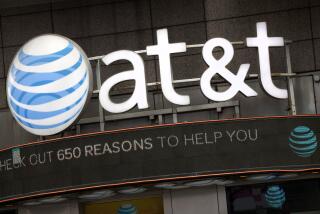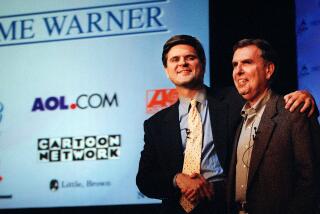AT&T; BREAKUP II : Highlights in the History of a Telecommunications Giant
- Share via
1900 -- AT&T; becomes the parent company of American Bell.
Early 1900s -- Seeking a monopoly, AT&T; refuses to allow rival phone companies to connect to its network until they sell out to AT&T.;
1910 -- AT&T; gains effective control of Western Union, its biggest telephone competitor.
1913 -- Under threat of an antitrust lawsuit, AT&T; agrees to dispose of Western Union stock and not to buy other independent phone companies without government approval.
1919 -- AT&T; is informally recognized as the nation’s telephone monopoly subject to federal regulation.
1956 -- In a controversial decision, the Dwight D. Eisenhower Administration ends a seven-year antitrust suit against AT&T.; By consent decree, AT&T; is allowed to keep its Western Electric manufacturing subsidiary in return for staying out of the computer business.
1969 -- FCC grants application by Microwave Communications Inc. (later MCI) to sell private long-distance lines between Chicago and St. Louis.
1974 -- MCI Communications Corp., and later the Justice Department, sue AT&T; on antitrust grounds.
1980 -- Federal jury in Chicago awards MCI $1.8 billion in antitrust damages from AT&T.;
1981 -- Opening arguments in U.S. vs. AT&T; are made. Defense Secretary Caspar W. Weinberger opposes the AT&T; breakup on national security grounds, but by year’s end AT&T; directors authorize the company to negotiate the breakup of the Bell system.
1982 -- Justice Department and AT&T; sign a landmark agreement breaking up the AT&T; monopoly by allowing long-distance competition and creating seven independent regional phone companies, dubbed the “Baby Bells.”
1984 -- Bell system breakup takes effect. AT&T; retains its Bell Laboratories research arm, Western Electric phone manufacturing arm and long-distance business.
1984 -- AT&T; enters the general-purpose computer business with a line of medium-range computers.
1985 -- In a retrial, MCI is awarded $113 million in antitrust damages from AT&T; instead of $1.8 billion.
1986 -- Plant consolidations and the expense of cutting 27,400 jobs reduce annual profit by $3.2 billion.
1988 -- A $6.7-billion write-down of old equipment causes AT&T;’s first-ever annual loss.
1990 -- AT&T; cuts long-distance rates an average of 2.2%, the 11th decrease since the breakup, for a total of 43%.
1991 -- After five months of negotiations, AT&T; signs a deal to buy computer maker NCR Corp., the former National Cash Register Corp., for $7.4 billion.
1991 -- Annual profit falls 83% due to the cost of a restructuring designed to eliminate 14,000 jobs by 1994 in former NCR businesses and its money-losing phone equipment business. Its long-distance market share, after years of losses to MCI, stabilizes at about 59%.
1992 -- Revenue from computer operations fall, the start of a downtrend.
1993 -- AT&T; signs a deal with China to improve its nationwide phone system.
1993 -- AT&T; agrees to buy McCaw Cellular Communications, the nation’s largest cellular phone company, for $12.6 billion.
1994 -- Company formally changes its name to AT&T; Corp. and reports annual earnings of $4.7 billion, its best year since the breakup.
1995 -- While AT&T; earnings rise with help from McCaw, computer operations continue to lose money.
1995 -- AT&T; announces it will voluntarily break into three companies: long distance-cellular, equipment research and manufacturing, and computers. A separate equipment leasing company will be sold.
More to Read
Inside the business of entertainment
The Wide Shot brings you news, analysis and insights on everything from streaming wars to production — and what it all means for the future.
You may occasionally receive promotional content from the Los Angeles Times.










